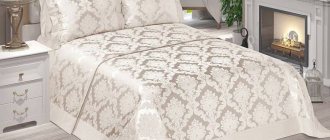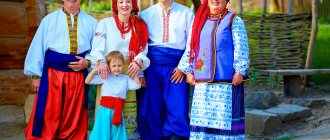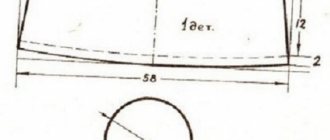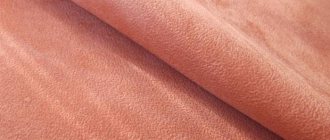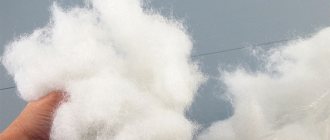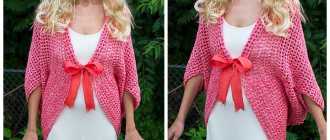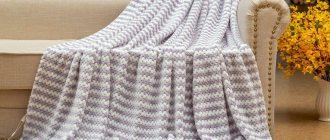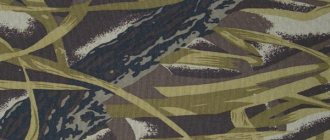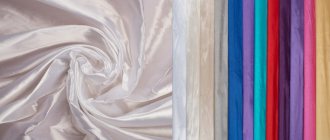Speaking about Russian modern camouflage, for a long time within the framework of this definition we mean not only those samples that are in production or are being supplied to various law enforcement agencies and bodies of the Russian Federation. Camouflage now includes military clothing, which is actively used by both military personnel and employees of other law enforcement agencies. It should be noted that technically among these camouflages there are those that were created back in the USSR. And in this article they are also classified as Russian for easier perception of the chronology. So, let's see how the shape and color of the workwear, developed primarily for the needs of the Russian army, changed.
"KZS"/"Coloring-57"
Historically, the first modern camouflage can be called a color scheme that has several names, the most common of which is “KZS”. It should be noted that KZS stands for “protective mesh suit”, and is not the name of the color, but the name of the product painted in this color. It is believed that the official name of the camouflage is “1957 pattern”, but this name is used quite rarely.
Sometimes this coloring is unofficially called “Berezka”, but such a name cannot serve as a unique name, since “Berezka” is also unofficially called another camouflage - VSR-93. Also, this coloring is sometimes called “border camouflage”, because for a long time it was supplied exclusively to the Border Troops of the KGB of the USSR.
Canada camouflage
CADPAT. Modification of MARPAT digital camouflage. There is debate as to who exactly was the first to come up with this type of camouflage. Let's not insist. Perhaps MARPAT is a modification of CADPAT. Perhaps it's the other way around. The principle of constructing camouflage colors is the same.
JACKET, GARRISON, LAND, Canadian forest camouflage. Suitable for both deciduous and coniferous forests.
Duck hunter. The glorious translation of "The Duck Hunter". Camouflage for hunters. It consists of large spots of color on olive or khaki. Sold in sporting and hunting stores
It is good because it is able to provide relative invisibility for animals, but the hunter remains visible to people, which is especially important when hunting.
"Butane"
This camouflage was developed in the USSR in the 1980s as the main pattern for field uniforms. Despite the production of a significant number of products from it, it was not particularly widespread among the troops, although it was quite effective. Currently found in the Russian Aerospace Forces and the Armed Forces of Ukraine (in Ukraine for a long time it was the main camouflage), but in both cases it is being actively removed from supply, being replaced by other models.
Other names for this camouflage are “Oak” and “Ameba”. The colors themselves can vary, only the scheme remains unchanged: a light green background, dark green spots and light brown amoeba-shaped intersecting ribbons.
In the 1990s, in many parts of the RF Armed Forces there was a situation where officers wore “Butan”, and privates and non-commissioned officers wore VSR-93, so in the 1990s this camouflage was sometimes called “officer.”
"VRS-93"
Developed in the early 1990s, accepted for supply in 1993. It replaced the ubiquitous khaki Afghan. When creating this camouflage, the experience of WWII camouflages, in particular, a number of German camouflages, was taken into account.
According to reviews of those wearing a uniform of this color, it is very good to lie in it, since the longitudinal spots very effectively imitate grass vegetation. However, camouflage is too highly specialized and is not universal and applicable to any terrain. In 1998, products of this color were removed from supply.
VSR-98 "Flora"
Accepted for supply to the RF Armed Forces as the main one in 1998, it replaced the VSR-93. When developing this camouflage, the results of a study of the dynamic efficiency of camouflage were taken into account, that is, the ability of camouflage not to lose its functions when an object moves. According to the study, horizontal stripes help maintain camouflage functions when an object moves, while vertical stripes, on the contrary, unmask when moving.
Unlike previous camouflages, VSR-98 has not only a digital code, but also an official name - “Flora”. However, unofficially, like the VSR-93, it was called “Watermelon” or “Horizontal Watermelon” in the army.
"Flora" was withdrawn from supply in 2009 (according to other sources, in 2011), giving way to a more modern color scheme.
Variety of fabrics for the production of summer camouflage suits
The following types of fabric are often used for summer camouflage clothing:
Oxford
Classic synthetic fabric, which consists of nylon and polyester. It has a square weave when the threads are woven together in the shape of squares. The main advantages of the fabric are durability, strength and water resistance, as well as resistance to chemical compounds. The material retains heat well and does not allow cold air to pass through.
Protective fabric
For your information! The fabric depends on the thickness of the threads and is divided into types from 210D to 600D. It is used to make clothes, shoes and military backpacks.
When washing, it is advisable to monitor the water, the temperature of which should not be higher than 50°C. It is better to choose cleaning products special for synthetic fabrics. When washing in a machine, you should set it to delicate; it is better to avoid spinning. You can dry things by hanging them on hangers. Then they don't need ironing.
Oxford material
Rip stop
The fabric contains polyester reinforced thread and cotton particles. Lattice-type weaving makes the fabric resistant to mechanical defects, that is, it will not unravel at the edges. This fabric hardly wrinkles, and also does not shrink with each wash. Wear-resistant and durable. It is advisable to wash at a temperature of about 40°C in hand wash mode. Can also be dried on hangers, no ironing required.
Greta fabric
The composition includes polyester and cotton. Due to the special type of weaving, the cotton thread is located on the inside of the material, and the synthetic thread is located on the outside. Greta has high wear resistance, retains heat well, and absorbs moisture well. It is advisable to wash at a temperature not exceeding 60°C. If this number is higher, the item will instantly lose its properties. The ideal mode is hand washing. Spin should not be higher than 600 rpm. Drying should be in a vertical position, and ironed only from the inside out.
Greta fabric
Fleece
To create this camouflage fabric, polar fleece fiber is used, which is 100% polyester. The fabric is created in such a way that there are air chambers in its structure. This fabric is hypoallergenic, lasts a long time, is pleasant to the touch, and does not shrink when washed. Wash only in synthetic mode, spin up to 600 rpm. Dry vertically. The material does not wrinkle, so there is no need to iron it.
You might be interested in: We sew a knitted hat ourselves
Shirt fabric
This is a mixed type of fabric made from polyester and viscose. It washes well, is soft to the touch and does not cause skin allergies. Caps and bandanas are also made from this fabric. Can be washed in warm water no higher than 70°C. Preferably in synthetic or cotton mode. When spinning, set it to no more than 1000 rpm. Ironing must be done in the same modes as washing.
Mixed material
Membrane
Membrane fabric does not hinder movement and protects well from rain, drafts and frost. Moisture from the body will escape, making the first layer of fabric dry. Wash carefully at a temperature not exceeding 40°C. It is better to rinse two or three times and avoid spinning. You need to dry it in a horizontal position, away from heating appliances.
Tarpaulin
A fairly dense and coarse material, which is created from thick yarn. The composition includes threads made of jute and cotton. The main characteristics of this fabric are strength and resistance to mechanical damage (cuts and tears). The fabric is wear-resistant and does not allow moisture to pass through. It is quite difficult to wash it, since water makes the material heavy and rough, which can also disrupt its impregnation.
Note! It is better to wash by hand using soap and a brush, and dry in a horizontal position.
Fabric tarpaulin
Avizent
Also called aircraft tarpaulin. This is a heavy material that is used for the production of awnings and high-strength equipment. It is highly resistant to mechanical damage and tearing. Caring for the fabric is exactly the same as for tarpaulin.
EMR/ZDU/Ruspat/Russian figure/Russian pixel
This camouflage appeared in 2008 (accepted for supply a year later), after a fundamental decision was made to change the “Flora”. Initially, it was assumed that since “Flora” roughly corresponds to the American “Woodland”, which the US Armed Forces are actively changing to “digital” camouflages, then the Russian Armed Forces should keep up with this process.
The creation of “EMP” (which stands for “Unified Camouflage Pattern”) was actively influenced by the German “Flecktarn” camouflage. Its developers managed to “combine the incompatible”: small spots that perform an imitation function are combined in this color scheme so that they form groups of large spots that perform a deforming function. The developers of EMP followed the same path, taking into account the results of studies that showed the effectiveness of extremely small (“pixel”) spots as constituent elements of a texture pattern. The result was "EMP".
Currently, “EMR” is the main camouflage used by the Russian Armed Forces. Interestingly, it is also supplied to the Belarusian Armed Forces, but it is believed that the Belarusian version of the “EMR” has a slightly different color scheme.
Camouflage in Russia and the Soviet Union
The digital camouflage of the Russian army is today called “digital flora”. Abroad, this suit is known as Russian Pattern, and in the Russian army it is referred to as “Pixel”. This suit was created in 2007, and was supplied to the military only a year after the decision was made to replace Flora.
You might be interested in this: How to make a beautiful felt hat yourself
Color “Birch”
Over the many years since the times of the USSR, the following types of camouflage have been created:
- "Amoeba". Created in 1935. Produced in three types;
- "Deciduous Forest" was created in 1942;
- "Palm". The camouflage pattern was created in 1944. Each season had its own suit;
- “Silver Leaf” was created in 1957. The army suit was also called “Beryozka”, or KGB camouflage. May be white or yellow;
- "Butane" or "Oak". Was created in 1984;
- Russian camouflage pattern released in 1993;
- "Undergrowth" camouflage is the first dual-frequency suit. Has good camouflage, but is very easily damaged;
- Digital Russian camouflage, which is worn in the army now;
- yellow camouflage "Flora" is mainly used by the troops of the North Caucasian Federal District in the summer, when the grass is faded.
Note! Many of these types of camouflage are optional. They have also found private use in security agencies.
Special Russian organizations also produce camouflage equipment that was developed in the West. In addition, Russia is constantly improving the functions of the suits that are currently available, and also creating new types of camouflage equipped with even better characteristics.
Forest suit
"Undergrowth"
Created in the early 1990s at the St. Petersburg NPO Spetsmaterialy as an alternative to the VSR-93 for adoption by the Ministry of Internal Affairs. When creating it, the same principles were followed as in “VSR-93”, however, the vertical stripes were made more angular, the brown color was replaced with black, and the base was made lighter than in “VSR-93”. When creating “Undergrowth,” it was taken into account that vertical stripes visually increase the height of a person in such camouflage, which is relevant for the Ministry of Internal Affairs, since an employee in such a uniform has an additional psychological impact on detainees.
Officially it was supplied to the Ministry of Internal Affairs and was actively used by various units of the Special Forces.
"Raster undergrowth"/"Raster"
It was created at the same NPO "Special Materials". It represents the first “dual-frequency” camouflage pattern in the practice of creating camouflage colors. The fact is that the original “Undergrowth” had a good imitation, but rather weak deforming effect, and therefore, when creating its improved version (“Rastra”), a twisted brown mesh network was applied in a special way to the original “Undergrowth” - it turned out to be a “double camouflage" or "camouflage on camouflage".
As a result, the original drawing of the “Undergrowth” is perceived by the eye as if at one frequency, and the superimposed “raster” network – at another, which contributes to the impossibility of intuitive perception of a person in such camouflage as an integral object. There is even a common rumor that if you just walk down the street in “Rastra”, you will not attract anyone’s attention - the eyes of passers-by will simply slide past.
Camouflages of the countries of the world. Types and purpose.
If you have visited this site, then you have heard the term “camouflage”, and most likely you also like to wear it. For many, this term is inextricably linked with the army, and this is not surprising, since the two concepts are closely related to each other. After all, it was the people serving in the troops who began to wear camouflage clothing; it was created for them. Now camouflage is widespread among the civilian population; it is worn not only by hunters and fishermen. The military clothing style is popular among people of different professions. On the streets of the city we can meet a man in a business suit and with an army watch on his hand, a woman walking with a child in a spotted park, young people playing sports in the fresh air in comfortable army pants. “Military” items impress with their comfort and durability; dirt is hard to see on them, and they “stretch” your figure well, allowing you to look more toned.
In this article I want to talk about camouflage options from around the world, which may be of interest not only to professional military personnel, but also to people in peaceful professions. And show how you can use such clothes in everyday life. But first, let's remember what camouflage is, where it came from and what it comes in.
Examples of camouflage patterns from different times and countries.
Camouflage is a spotted camouflage color that reduces the visibility of the camouflaged object (person, weapon, equipment) by breaking up its silhouette.
Military uniforms began to be specially made from camouflage-colored fabrics at the end of the 19th and beginning of the 20th centuries. The first to massively use camouflage colors in combat were the British colonial troops in India. The uniform of these troops was khaki, which in Persian means the color of dust. This color scheme performed well on the battlefield in the South African Boer War of 1899–1902.
In 1909, the American artist Abbott Thayer published the book “Color in the Animal World”, on its basis the principles of the first military camouflage were developed. In 1939, Vladimir Baranov-Rossinet, a French artist of Russian origin, patented a spotted military uniform.
By the beginning of the Second World War, camouflage was widely used in all branches of the military, taking into account the geographical features of the location of the intended battle. In 1984, “digital” camouflage was created: a pattern similar to the configuration of pixels on a monitor screen was applied to a soldier’s uniform. This pattern prevents the eye from fixating on the object. Currently, there is a worldwide desire to have one universal pattern for all armies, modified in color in accordance with the local type of terrain.
Over more than a hundred years of its history, army camouflage has undergone many changes and has now reached a high level of effectiveness, practicality and availability. There are many types of camouflage, but as an example, let’s look at the most popular types of camouflage from NATO countries. For convenience, the colors will be divided into blocks corresponding to the natural region of application.
Forest camouflages.
Woodland
Prominent representatives of forest camouflages include the following patterns: woodland, dpm, flecktarn, vegetato, marpat woodland and oliv. The most famous and common color is woodland. This camouflage began to be developed in the mid-seventies. It was intended for camouflage in forest areas. Woodland camouflage is a classic among camouflages. Therefore, if you need reliable, time-tested camouflage, then this is your choice.
Flecktarn
The German flecktarn camouflage deserves special mention. We can say that he is the leader among foreign camouflages in Russia. The flecktarn camouflage was adopted by the German army in the nineties, it has proven itself excellently and has since had an impeccable reputation. Excellent camouflage in Central European latitudes. From my own experience I can give an example: in an ordinary forest near Moscow, from a distance of five meters, it is difficult to notice a person dressed in this camouflage. Also, the fact that this camouflage is still in service with the German army and there are no plans to change it yet speaks for itself.
DPM
English dpm is also very common in our country, although its camouflage properties are somewhat lower than those of German camouflage. The advantage is its availability and relatively low price, since the British armed forces removed it from service and replaced it with another design, which I will discuss below. The combination of price, quality and good camouflage properties makes the uniform in this color a good choice for hunting and fishing.
Olive Austria
Austria is one of the few countries that has switched from camouflage to solid colors, and not vice versa. Since at long distances almost any camouflage looks like a single color, the Austrian military decided to stick to a plain olive uniform and equipment. This color performs its tasks well, so it is suitable for any task. Also, a uniform of this color can be easily worn in the city without standing out.
Marpat Woodland
The US Marine Corps did not reinvent the wheel and until a certain point wore a regular woodland, but when it came time to change it, they simply “broke it into pixels” using a computer and the famous marpat woodland turned out. This camouflage will mainly be of interest to airsoft players and reenactors, as it has a fairly high price due to the rarity and complexity of supplies to our country.
Vegetato
One cannot help but remember the Italians, they use vegetato as forest camouflage. It is beautiful from an aesthetic point of view, but a bit light for our latitude. Although everything in this world is relative, therefore, if you want a beautiful design and high-quality shape, then vegetato is your choice.
In conclusion, we can add that any camouflage of forest colors is suitable for solving problems in our latitudes.
Desert camouflages.
Des 3
Desert camouflages include such colors as desert 3, desert 6, marpat desert, khaki, tropentarn, desert dpm and desert vegetato. But speaking chronologically, the khaki colorway was created and applied first. Its effectiveness was confirmed at the beginning of the twentieth century. At the moment, uniforms in this color are used by countries such as Austria, Germany and the USA. This color not only camouflages well against the backdrop of sandy terrain, but is also suitable for wearing in urban environments, since a person wearing such clothes will not attract attention.
Des 6
Desert-6 camouflage was developed for combat operations in desert areas. It performed well in the Nevada desert, but when it came to the Gulf War, the military realized that all was not well. The stumbling block was the other natural colors of the Iraqi desert and other temperature conditions. So the army gave technical specifications for the development of a more effective camouflage pattern, and this became the desert-3 camouflage. It remained in service until the 2000s, and special forces troops still use it to this day.
Marpat Desert
With the advent of the first pixel art in the army, the Marine Corps also thought about a new desert camouflage for their units and simply changed the colors in the basic marpat woodland pattern. This is how marpat desert appeared, which is also successfully used in the desert. In our country, this color is not often found on sale and therefore is not cheap.
Tropentarn
The Germans, as well as the Marine Corps, simply changed the colors in the basic pattern to create a very effective tropentarn desert camouflage pattern. It has proven its effectiveness in Afghanistan more than once. Together with the very durable and reliable material, the uniform in this color will be an excellent choice in the hot season. But the English desert dpm camouflage is perhaps most suitable for use in the desert. Its pattern, the pattern of which follows the usual dpm, consists of only two colors and perfectly camouflages against the background of sand. The material from which the uniform is made is very light and perfect for hot climates.
Vegetato Desert
Finally, we need to mention Italy. Its pixelated desert camouflage is not only effective, but also beautiful. Combined with reliable material and thoughtful cut, military uniforms in this camouflage pattern can compete with many others.
At the moment, the most easily available camouflage colors for sale are, in my opinion, desert 3 and dpm desert, but the rest can also be found and purchased if desired.
Universal camouflages.
Desert DPM and MTP
At the beginning of the 21st century, the army of different countries formed the concept of the need to develop one universal camouflage that would work equally well on any terrain. This is how the camouflage colors UCP, Multicam and MTP were born.
Multicam and UCP
UCP, aka ACUPAT, was created first and was created as a uniform camouflage pattern for the US Army. The developers assumed that combat operations would be conducted against an enemy armed with the latest technology, and created a pattern that was difficult to see with night vision devices. In reality, everything turned out to be not entirely true. The real enemy used conventional optical devices, and camouflage was not effective. However, this camouflage works well in mountainous areas with a gray landscape, in the city and just great in birch groves.
Later, when the US Army realized its failure, Multicam was developed, which eventually replaced the UCP. It contains sand and green shades, which makes it quite effective on almost any terrain. It should be noted that Multicam has gained great popularity in our country due to its versatility.
MTP
The British also adopted the American concept and created mtp camouflage, which differs from the Multicam colors in minor details of the pattern. A non-specialist will not be able to distinguish multicam from mtp at first glance. It works just as well on the ground and has greater variety in uniform patterns, and most importantly, lower cost. Thus, for a civilian, mtp camouflage can be a good alternative to the Multicam flourish.
TAZ 83 in the Alps
Separately, I would like to mention the Swiss camouflage taz 83. The fact is that it cannot be classified into any of the groups described above. Due to the country's defensive policy, the Swiss army did not have and does not have plans to fight on foreign territory. And in the mountainous regions of Switzerland, red moss grows, against which the taz 83 camouflage is designed to camouflage. Therefore, it contains a bright red color. In addition to the unusual original colors, the low cost of the uniform and high quality tailoring are captivating.
***
In conclusion, I want to say the following. Each camouflage pattern performs well in the area for which it was made. When choosing a color, you need to consider what terrain you will use it on and what tasks you will set for yourself. These simple principles will help you choose and apply any camouflage correctly.
***
“We work throughout Russia: St. Petersburg, Novosibirsk, Yekaterinburg, Nizhny Novgorod, Kazan, Chelyabinsk, Omsk, Samara, Rostov-on-Don, Ufa, Krasnoyarsk, Perm, Voronezh, Volgograd, etc.
"Tiger"/"Reed"
Strictly speaking, although this camouflage is produced in the Russian Federation on an industrial scale by various companies and, moreover, is widely used in various law enforcement agencies, it is not a Russian development - it is rather an adaptation of the existing Malaysian “Tiger Stripe” camouflage to Russian conditions.
If the “Tiger” was the result of a deliberate alteration of an existing foreign analogue, then the “Kamysh” appeared due to an accident when the manufacturer mistakenly sewed the uniform so that the stripes of the “Tiger” turned out to be vertical. However, the classic “Tiger” is often called “Kamysh”.
Officially, it was never in supply, but unofficially it is used by all law enforcement agencies, although now its popularity is falling due to the advent of more effective colors.
